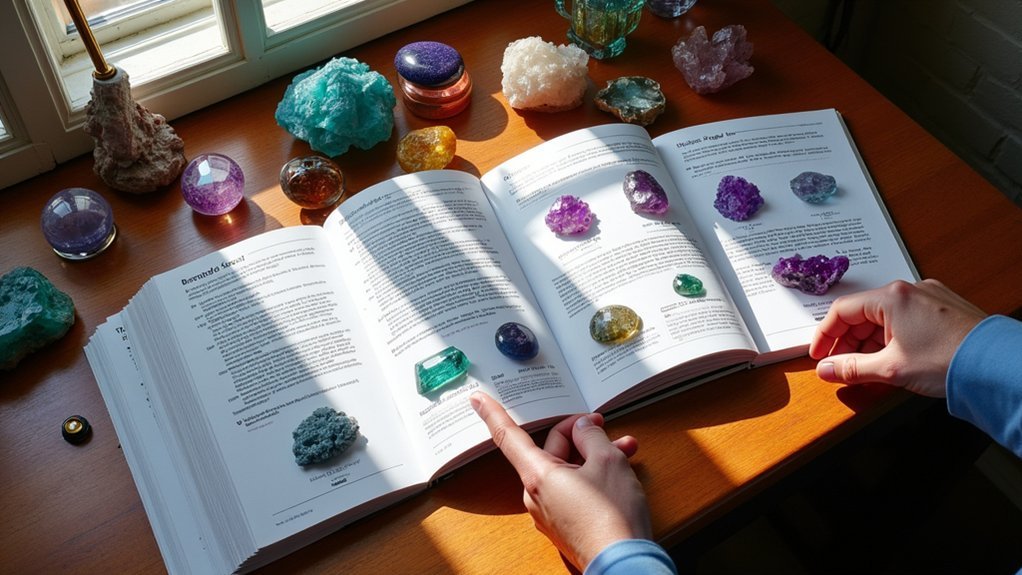Ever noticed how gemstone guides often promise expertise but deliver confusion? You’re not alone. Whether you’re examining that mysterious crystal from a tucked-away shop or sorting through your growing collection, having a reliable identification resource makes all the difference. Mineralogists have tested dozens of guides and found just five that consistently deliver accurate results. These standouts combine scientific precision with practical usability—exactly what you need when that enchanting specimen defies easy classification.
Healing Crystals: The A – Z Guide to 555 Gemstones
Crystal enthusiasts seeking a portable reference will find this pocket-sized guide indispensable. You’ll appreciate the concise descriptions of 555 gemstones, perfect for quick reference while shopping or organizing your collection.
Written by a renowned crystal healing expert, the guide provides essential information on physical and emotional properties without overwhelming detail. The included checklist helps you track common, rare, and scarce specimens in your collection.
Though it lacks extensive imagery, users consistently report that the information resonates more authentically than other crystal literature. The straightforward layout makes it valuable for both beginners and experienced collectors.
Best For: Crystal enthusiasts, beginners, Etsy sellers, and practitioners of crystal healing seeking a portable, concise reference guide for the healing properties of 555 gemstones.
Pros:
- Pocket-sized format makes it convenient and portable for reference while shopping or organizing a collection
- Includes a helpful checklist feature to track common, rare, and scarce specimens in your collection
- Written by a renowned crystal healing expert whose information resonates more authentically than other crystal literature
Cons:
- Lacks extensive imagery and detailed photos of the gemstones
- Some crystals are not grouped together logically, requiring knowledge of multiple names to locate them
- Limited in-depth information compared to more comprehensive crystal healing resources
National Geographic Pocket Guide to Rocks and Minerals of North America
The compact National Geographic Pocket Guide offers an ideal solution for rock enthusiasts who need on-the-go identification without carrying bulky references. Its vibrant illustrations and thorough content make identifying specimens quick and consistent whether you’re a beginner or professional.
You’ll appreciate its durability during field excursions, and children find it especially accessible for learning geology basics. The guide covers everything from simple minerals to complex formations, though some users note it omits Mexican specimens despite the “North America” title.
For rock-hounding adventures or educational purposes, this pocket-sized resource delivers substantial value while remaining conveniently portable.
Best For: Rock collectors and geology enthusiasts of all ages who need a portable, reliable identification guide for field trips and outdoor exploration.
Pros:
- Compact size makes it perfect for carrying during rock-hounding excursions without adding bulk
- Vibrant illustrations and comprehensive content help with quick and accurate identification
- Particularly accessible for children, making it an excellent educational tool for young geology enthusiasts
Cons:
- Lacks coverage of Mexican rocks and minerals despite “North America” in the title
- May not contain enough depth for advanced geology professionals
- Some users might prefer larger illustrations for more detailed examination
Gemstones: A Concise Reference Guide
Published in 2022, “Gemstones: A Concise Reference Guide” offers gem enthusiasts a pocket-sized treasure trove of information within its 240 pages. Author Robin Hansen, from London’s Natural History Museum, organizes gems by familiarity rather than chemical classification.
You’ll appreciate the high-quality photographs essential for identification, alongside thorough details about treatments, localities, and properties. While some readers note the font is small, most praise its well-written, accessible content.
Unlike “The Crystal Bible,” this reference omits some stones like Agate and Pyrite. Nevertheless, it’s highly recommended for both beginners and experienced gemologists who need a portable, visually rich identification resource.
Best For: Gem enthusiasts and gemologists seeking a portable, visually rich reference guide with detailed information on well-known gemstones.
Pros:
- High-quality photographs that aid in proper gemstone identification
- Comprehensive information on treatments, localities, and properties of various gemstones
- Pocket-sized format makes it convenient for field work or travel
Cons:
- Font size is too small, making it difficult to read for some users
- Lacks coverage of certain popular stones like Agate, Amazonite, and Pyrite
- Organized by familiarity rather than chemical classification, which might not suit those seeking more technical organization
The Illustrated Directory of Healing Crystals: Guide to 150 Crystals and Gemstones
Renowned for its accessible approach to crystal healing, “The Illustrated Directory of Healing Crystals” serves as an ideal companion for beginners and intermediate practitioners seeking an extensive visual reference. You’ll find 150 crystals organized by color, each accompanied by high-quality photographs and detailed descriptions covering mythology, divinatory significance, and practical uses.
The book includes helpful tables listing each stone’s properties and associations (zodiac, planet, chakra, etc.), making it easy to identify the right crystal for your needs. While it lacks sourcing information that advanced users might want, its thorough organization and visual appeal have made it a highly recommended resource in the crystal healing community.
Best For: Beginner to intermediate crystal enthusiasts seeking a well-organized, visually-driven reference guide with comprehensive information on a wide range of healing crystals.
Pros:
- Excellent organization by color with high-quality photographs makes crystal identification straightforward and intuitive
- Comprehensive information tables for each crystal include associations with zodiac signs, planets, chakras, and complementary elements
- Provides practical guidance on crystal healing, cleansing methods, and empowerment techniques suitable for meditation and home use
Cons:
- Lacks information on sourcing stones, which limits practical application for those wanting to ethically purchase crystals
- May be too basic for advanced practitioners seeking deeper metaphysical knowledge
- Could benefit from more images showing both raw and tumbled versions of each stone for better visual reference
Rockhounding for Beginners: Guide to Finding and Collecting Minerals
For aspiring mineral collectors just starting their journey, “Rockhounding for Beginners” delivers essential knowledge with impressive visual guidance through excellent color photographs of rocks, gems, and fossils.
The book excels at explaining tools, equipment, safety protocols, and mineral identification basics in an engaging, accessible tone suitable for readers 12 and older. While some reviewers mention it’s occasionally too simplified for advanced collectors, it’s widely praised as an ideal first book in the field. You’ll appreciate the well-organized approach showing both raw and polished specimens alongside location information. Despite minor complaints about packaging and some overly detailed sections, it accomplishes its core mission effectively.
Best For: Novice rockhounding enthusiasts ages 12 and up who need a visually-rich introduction to mineral collecting fundamentals.
Pros:
- Excellent color photographs showing both raw and polished specimens make identification easier for beginners
- Well-organized content covering essential tools, safety protocols, and location guidance in an engaging, accessible tone
- Provides a comprehensive foundation of knowledge that serves as an ideal first book in the field
Cons:
- Too simplified for advanced collectors seeking in-depth geological information
- Some sections contain excessive detail on peripheral topics like first-aid
- Multiple reports of books arriving damaged due to packaging issues
Factors to Consider When Choosing Gemstone Identification Guides That Actually Work
When you’re selecting a gemstone identification guide, you’ll want to carefully consider several key factors that determine its practical value. Look for guides that offer reliable information, high-quality images, appropriate size for field use, and thoughtful organization that makes identification easier. Your choice should balance technical accuracy with usability, ensuring you can quickly reference critical details when examining potential specimens.
Subheading Discussion Points
Selecting the right gemstone identification guide can make the difference between accurate identification and costly mistakes. When evaluating guides, prioritize those with high-quality imagery—visual references are essential for distinguishing similar stones and identifying subtle characteristics.
Consider how information is organized; guides arranged by color may help beginners, while those organized by mineral group benefit advanced users. The best resources include thorough details on physical properties, localities, and common treatments that affect value.
Look for user-friendly features like comparison charts and reference tables that allow quick access to critical information. Finally, match the guide’s complexity to your expertise level—beginners need clear, simplified explanations, while professionals require technical details and scientific precision in their reference materials.
Accuracy of Information
The reliability of information stands as the cornerstone of any effective gemstone identification guide. When selecting a resource, you’ll want one that provides thorough physical property descriptions, accurate locality information, and evidence-based healing properties.
Look for guides that cross-reference data from multiple authoritative sources—this approach greatly enhances accuracy and reliability. High-quality photographic images are essential for visual comparison, allowing you to confidently identify specimens in your collection.
The best guides include scientific classification details and information about common treatments, helping you distinguish natural stones from enhanced ones. Before purchasing, check user reviews and feedback, as these often reveal how accurate the guide proves in real-world applications. This community-verified approach guarantees you’re investing in a resource that genuinely delivers on its promises.
Image Quality Matters
High-quality images serve as your window into the gemstone world, making them perhaps the most critical element in any identification guide worth purchasing. When evaluating potential guides, pay close attention to the resolution and clarity of photographs, as these details will directly impact your ability to correctly identify specimens.
The best guides feature vibrant, accurate colors and sharp details that reveal distinctive characteristics of each stone. Look for publications that include both raw and polished examples of the same gemstone—this dual perspective helps you recognize specimens regardless of their form.
You’ll retain information better when visual references resonate with your experience, so prioritize guides with professional photography. Clear, detailed images don’t just enhance the aesthetic appeal; they’re essential educational tools that transform abstract descriptions into recognizable visual patterns.
Size and Portability
When selecting gemstone identification guides for field work or shopping trips, portability often determines whether your resource ends up in your bag or left on the shelf at home. Pocket-sized guides enable quick access to critical information without weighing you down during expeditions or marketplace visits.
The best compact guides maximize their limited space with efficient features like checklists and thorough indexes, helping you track your collection on the go. Despite their smaller dimensions, quality portable guides maintain clear, detailed images that aid accurate identification.
Don’t overlook durability factors when considering portability. Guides with sturdy bindings and weather-resistant materials will withstand frequent use in outdoor environments. The ideal portable guide strikes a perfect balance—compact enough to carry anywhere yet robust enough to provide the essential information you’ll need in the field.
Organization and Layout
Effective organization within gemstone identification guides makes the difference between quick discoveries and frustrating searches. Look for guides that categorize stones logically—whether by color, type, or popularity—allowing you to navigate directly to relevant sections.
Well-designed guides feature clear headings and consistent formatting throughout, enabling efficient comparison between different specimens. This consistency helps you quickly identify distinguishing characteristics without wasting time deciphering varying layouts.
The most practical guides incorporate visual elements alongside text descriptions. High-quality photographs provide visual reference points that text alone can’t convey. Additionally, tables and charts summarizing key properties (hardness, luster, specific gravity) create valuable quick-reference tools.
When evaluating potential guides, flip through and assess how intuitively the information flows—you’ll be grateful for thoughtful organization when you’re in the field identifying specimens.
Expert Authorship Credentials
Behind every trustworthy gemstone identification guide stands an author whose expertise transforms complex mineralogical concepts into accessible knowledge. When evaluating guides, you’ll want to scrutinize the writer’s background in geology or gemology, as this directly impacts the accuracy and depth of information you’ll receive.
Seek out guides written by recognized authorities who bring practical experience to their work. Authors affiliated with respected institutions like natural history museums or gemological societies offer superior credibility and insight. Check if they’ve published other works or made notable contributions to the field.
The best guides include firsthand expertise and practical advice that benefit both beginners and experienced collectors. An expert’s perspective provides you with reliable identification techniques and nuanced understanding that amateur authors simply can’t match.
Frequently Asked Questions
How Can I Distinguish Between Natural and Synthetic Gemstones?
You can distinguish natural from synthetic gemstones by checking for inclusions, using a jeweler’s loupe, observing color consistency, and testing thermal conductivity. Natural stones often have imperfections that synthetics lack.
What Simple Home Tests Can Verify a Gemstone’s Authenticity?
You can verify gemstone authenticity at home using these simple tests: check for bubbles with a loupe, conduct thermal testing, use UV light, test specific gravity with water, and check for color under different lighting.
Which Portable Tools Are Best for Field Identification?
You’ll need a 10x loupe, portable refractometer, electronic diamond tester, UV light, and polariscope for field identification. Don’t forget a hardness testing kit with Mohs scale reference materials for quick assessments.
How Do Gemstone Values Change With Different Inclusions?
Some inclusions decrease value, while others increase it. You’ll find “eye-clean” gems typically command higher prices, but unique inclusions like “horsetails” in demantoid garnets can actually boost their value considerably.
Can Smartphone Apps Accurately Identify Gemstones?
Most smartphone apps can’t accurately identify gemstones. You’ll find they provide basic assessments but miss essential details. For precise identification, you’re better off consulting professional gemologists or using specialized testing equipment.





Leave a Reply